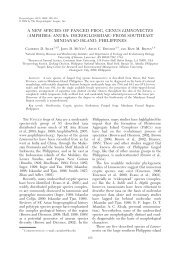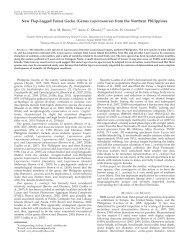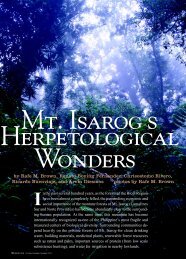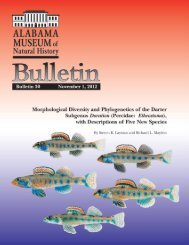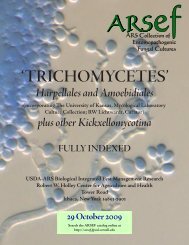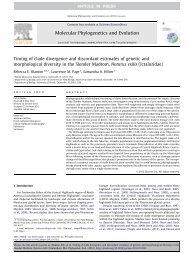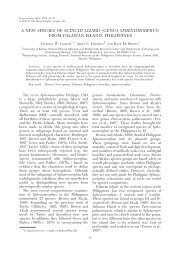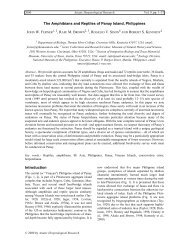Zootaxa, Crystallaria cincotta, a new species of darter (Teleostei ...
Zootaxa, Crystallaria cincotta, a new species of darter (Teleostei ...
Zootaxa, Crystallaria cincotta, a new species of darter (Teleostei ...
Create successful ePaper yourself
Turn your PDF publications into a flip-book with our unique Google optimized e-Paper software.
<strong>Zootaxa</strong> 1680: 62–68 (2008)www.mapress.com/zootaxa/Copyright © 2008 · Magnolia PressISSN 1175-5326 (print edition)ZOOTAXAISSN 1175-5334 (online edition)<strong>Crystallaria</strong> <strong>cincotta</strong>, a <strong>new</strong> <strong>species</strong> <strong>of</strong> <strong>darter</strong> (<strong>Teleostei</strong>: Percidae) from the ElkRiver <strong>of</strong> the Ohio River drainage, West VirginiaSTUART A. WELSH 1 & ROBERT M. WOOD 21U.S. Geological Survey, West Virginia Cooperative Fish and Wildlife Research Unit, 322 Percival Hall, Morgantown, WV 26506–6125, USA. E-mail: swelsh@wvu.edu2Department <strong>of</strong> Biology, Saint Louis University, 3507 Laclede, St. Louis, MO 63103–2010, USA. E-mail: wood2@slu.eduAbstractA <strong>new</strong> <strong>species</strong> <strong>of</strong> percid, <strong>Crystallaria</strong> <strong>cincotta</strong>, is described from the Cumberland, Elk, Green, and Muskingum riverdrainages <strong>of</strong> the Ohio River basin, USA. It differs from populations <strong>of</strong> <strong>Crystallaria</strong> asprella <strong>of</strong> the Gulf Coast, lowerMississippi River, middle Mississippi River, upper Mississippi River, and Wabash River drainages by having a reducednumber <strong>of</strong> cheek scale rows restricted to the post-orbital region, a falcate margin on the pelvic fins, a preorbital blotchdistinctly separate from the anterior orbital rim, and a wide mouth gape. The Elk River population is also divergentgenetically from populations <strong>of</strong> the Gulf Coast, lower Mississippi River, and upper Mississippi River drainages. <strong>Crystallaria</strong><strong>cincotta</strong>, discovered in the Elk River <strong>of</strong> the Ohio River drainage in 1980, is a rare <strong>species</strong> with the only extant populationrepresented by 12 individuals collected from 1980–2005 from the lower 36 km section <strong>of</strong> the Elk River, WestVirginia.Key words: <strong>new</strong> <strong>species</strong>, <strong>darter</strong>, Percidae, <strong>Crystallaria</strong>, Elk RiverIntroduction<strong>Crystallaria</strong> asprella (Jordan), the crystal <strong>darter</strong>, was recognized as the sole member <strong>of</strong> a monotypic genus(Simons 1991). The crystal <strong>darter</strong> has a wide and fragmented geographic distribution within the MississippiRiver system (Page 1983), including population segments in the Gulf Coast, lower Mississippi River, middleMississippi River, and upper Mississippi River (Morrison et al. 2006). Museum specimens from the Cumberland,Green, Muskingum, and Wabash rivers support a previous wide-spread distribution <strong>of</strong> <strong>Crystallaria</strong>within the Ohio River drainage. A population in the Elk River, WV (Ohio River drainage) was discovered in1980 (Cincotta and Hoeft 1987). A total <strong>of</strong> 12 individuals have been collected from Elk River during 1980–2005. Genetic diversity <strong>of</strong> <strong>Crystallaria</strong> was examined at the mitochondrial cytochrome b gene (Wood andRaley 2000) and at two additional loci; the mitochondrial control region, and an intron <strong>of</strong> the nuclear S7 ribosomalprotein (Morrison et al. 2006). Wood and Raley (2000) and Morrison et al. (2006) both reported thatthe Elk River population was genetically divergent from the Gulf Coast, lower Mississippi River, and upperMississippi River populations. Our objective is to provide morphologic data to supplement the genetic evidencein support <strong>of</strong> the <strong>new</strong> <strong>species</strong> status <strong>of</strong> the extant Elk River population <strong>of</strong> <strong>Crystallaria</strong>.Material and methodsIn addition to the genetic data <strong>of</strong> Wood and Raley (2000) and Morrison et al. (2006), this study is based on62Accepted by L. Page: 6 Dec. 2007; published: 14 Jan. 2008
Mississippi. MMNS 28727 (30, 64–106) Itawamba Co., East Fork <strong>of</strong> Tombigbee River, 19 Sept. 2001.Arkansas. NLU 48454 (11, 75–90) Bradley Co., Saline River, 26 Sept. 1981. NLU 48646 (15, 72–88)Bradley Co., Saline River, 17 Oct. 1981. MMNS 32293 (3, 68–72) Lawrence Co., Strawberry River, 23 May1991.<strong>Crystallaria</strong> <strong>cincotta</strong>, <strong>new</strong> <strong>species</strong>Diamond DarterFig. 2, Table 1Holotype. UMMZ 233255, 73 mm SL, West Virginia, Kanawha Co., Elk River,1.6 km upstream <strong>of</strong> mouth <strong>of</strong>Big Sandy Creek, Clendenin, WV, 18 July 1991, D.A. Cincotta, M.E. Hoeft, and S.F. Morrison.Paratypes. West Virginia. USMF (Frostburg State University, Frostburg, MD) 200616 (1, 73 mm SL)taken with holotype. USMF 200617 (1, 76), Kanawha Co., Elk River, 1.6 km upstream <strong>of</strong> mouth <strong>of</strong> Big SandyCreek, Clendenin, WV, 25 Aug 1999. USMF 200618 (2, 75–76) Kanawha Co., Elk River, 150 m downstream<strong>of</strong> mouth <strong>of</strong> Big Sandy Creek, Clendenin, WV, 29 Aug. 2003. USMF 200619 (2, 76–77) Kanawha Co., ElkRiver, 150 m downstream <strong>of</strong> mouth <strong>of</strong> Big Sandy Creek, Clendenin, WV, 8 July 2005.Additional material (nontypes).Ohio. OSUM 8996 (1, 72 mm SL) Washington Co., Muskingum River, 31 Aug. 1888. OSUM 9688 (1,51) Lawrence Co., Ohio River, 31 May 1899. Kentucky. USNM 63786 (1, 77) Green Co., Green River, 1890.USNM 89467 (2, 37–49) Edmonson Co., Green River, 31 Aug. 1929. FMNH 6825 (1, 67) Lyon Co., CumberlandRiver, date unknown.Diagnosis. A <strong>species</strong> <strong>of</strong> <strong>Crystallaria</strong> that differs from populations <strong>of</strong> C. asprella <strong>of</strong> the Gulf Coast, lowerMississippi River, middle Mississippi River, upper Mississippi River, and Wabash River by a combination <strong>of</strong>the following characters: a larger gape width approximately equal to or exceeding the inter-pelvic fin basewidth, a preorbital blotch distinctly separate from the anterior orbital rim, pelvic fins distinctly falcate in bothsexes, cheek scale rows reduced (modally 2), opercle scale rows reduced (modally 2), a high count <strong>of</strong> mid-lateralblotches (modally 13), a low count <strong>of</strong> anal-fin rays (modally 13), a low count <strong>of</strong> dorsal-fin spines (modally12), and a high count <strong>of</strong> scales below the lateral line (modally 11).FIGURE 2. <strong>Crystallaria</strong> <strong>cincotta</strong>, 75 mm SL male, Elk River, West Virginia.Description. Morphometric measurements (as percentage <strong>of</strong> SL) are given in Table 1. Dorsal-fin spines(11–13, modally 12), dorsal-fin rays (11–15, modally 13), anal-fin rays (11–13, modally 13), principal caudalrays (17), lateral-line scales (83–93, modally 87), cheek scale rows restricted to the post-orbital region (1–4,modally 2), opercle scale rows (1-4, modally 2), mid-lateral blotches (12–14, modally 13), breast and bellywithout scales, gape width approximately equal to or greater than inter-pelvic fin width. Pelvic fins with falcateposterior margin. Preorbital blotch distinctly separate from the anterior orbital rim.64 · <strong>Zootaxa</strong> 1680 © 2008 Magnolia PressWELSH & WOOD
TABLE 1. Morphometric data from a box-truss network <strong>of</strong> measurements for the holotype and paratypes <strong>of</strong> <strong>Crystallaria</strong><strong>cincotta</strong>. Distance measurements are presented as thousandths <strong>of</strong> standard length.Paratypes (n=6)Distances Holotype Mean SD RangeStandard length (mm) 73.3 75.4 1.5 73.0–77.3Snout–occiput 215.4 211.9 4.8 206–218Occiput–first dorsal-fin spine 141.3 146.7 7.3 136–158Base <strong>of</strong> fist dorsal fin 283.6 287.5 14.7 273–309Base <strong>of</strong> second dorsal fin 137.0 156.0 15.0 139–181Last dorsal-fin ray–dorsal caudal flexure 262.9 265.4 16.2 239–281Depth at caudal flexure 84.6 82.5 4.6 76–89Last anal-fin ray–ventral caudal flexure 241.3 242.8 10.9 228–255Base <strong>of</strong> anal fin 182.9 182.8 7.1 172–193Mid-point between pelvic-fin bases–first anal-fin ray 300.3 305.5 9.5 295–322Branchiostegal connection–midpoint between pelvic-fin bases 200.7 200.6 6.3 191–207Snout–branchiostegal connection 136.4 131.6 11.3 114–144Branchiostegal connection–occiput 171.9 148.1 8.0 138–162Branchiostegal connection–first dorsal-fin spine 260.0 250.4 8.3 238–261Occiput–mid-point between pelvic-fin bases 155.4 172.7 11.9 155–192Mid-point between pelvic-fin bases–first dorsal-fin spine 113.1 127.1 14.2 111–152Mid-point between pelvic-fin bases–second dorsal-fin insertion 356.9 331.8 17.6 313–361First dorsal-fin spine–anal-fin insertion 291.8 296.4 10.3 285–310Anal-fin insertion–second dorsal-fin insertion 105.3 109.7 2.8 106–114Anal-fin insertion–last dorsal-fin ray 190.7 177.5 13.1 162–195Second dorsal-fin insertion–last anal-fin ray 177.6 188.0 6.7 180–199Last dorsal-fin ray–last anal-fin ray 68.9 76.6 6.2 69–84Last anal-fin ray–dorsal caudal flexure 255.9 252.5 16.2 233–280Last dorsal-fin ray–ventral caudal flexure 259.6 273.0 7.8 265–286Snout–anterior margin <strong>of</strong> eye 87.0 91.0 2.7 88–94Eye width 77.5 75.3 3.7 71–82Snout–opercle spine tip 257.2 262.3 5.7 255–271Anterior internasal width 42.2 49.6 2.0 46–52Posterior internasal width 55.4 57.9 2.3 56–62Interorbital width 33.8 30.7 1.4 30–33Gape width 84.6 81.0 4.6 76–88Interpelvic base width 73.4 74.4 3.1 70–77Body is overall translucent. Olive brown melanophores are concentrated as four wide saddles on the backand dorsal sides. Saddles angle anteriad on dorsal sides and are outlined with anterior and posterior dark margins.Between the saddles, olive brown melanophores on scale margins produce a fragmented cross-hatch pattern.The ventral sides <strong>of</strong> the body and head are silvery white. A preorbital blotch is dark and distinctlyseparated from the anterior margin <strong>of</strong> the orbital rim. The mid-lateral pigmentation includes 12–14 oblongolive-brown blotches overlain by an iridescent olive green stripe. Fins are clear with the exception <strong>of</strong> sparsepigmentation on the caudal fin.CRYSTALLARIA CINCOTTA, A NEW SPECIES OF DARTER<strong>Zootaxa</strong> 1680 © 2008 Magnolia Press · 65
Comparisons. <strong>Crystallaria</strong> <strong>cincotta</strong> differs from populations <strong>of</strong> C. asprella <strong>of</strong> the Gulf Coast, lower MississippiRiver, middle Mississippi River, upper Mississippi River, and Wabash River by a combination <strong>of</strong> thefollowing characters: gape width approximately equal to or exceeding the inter-pelvic fin base width (gapewidth 7.3–8.6% SL vs. 3.7–6.1), preorbital blotch distinctly separate from anterior orbital rim vs. preorbitalblotch adjoined to or narrowly separate from anterior orbital rim, and pelvic fins distinctly falcate vs. pelvicfins not falcate. Additionally, a combination <strong>of</strong> the following meristic characters separate C. <strong>cincotta</strong> from C.asprella; cheek scale rows reduced (1–4, modally 2 vs. 4–14, modally 11), opercle scale rows reduced (1–4,modally 2 vs. 2–13, modally 4), a higher modal count <strong>of</strong> mid-lateral blotches (12–14, modally 13 vs. 8–14,modally 10), a lower count <strong>of</strong> anal-fin rays (11–13, modally 13 vs. 12–16, modally 14), a lower count <strong>of</strong> dorsal-finspines (11–13, modally 12 vs. 10–17, modally 14), a higher count <strong>of</strong> scales below the lateral line (10–14, modally 11 vs. 7–14, modally 9, Table 2). Additionally, C. <strong>cincotta</strong> differs from the Gulf, lower Mississippi,and upper Mississippi populations <strong>of</strong> C. asprella by cytochrome b sequence divergence (11.31, 11.95,and 11.84%; Wood and Raley 2000), and net nucleotide divergences <strong>of</strong> the mitochondrial control region (4.97,5.25, and 4.39%) and the nuclear S7 intron (2.25, 2.03, and 2.04%; Morrison et al. 2006). Genetic evidencesupports the <strong>species</strong> recognition <strong>of</strong> C. <strong>cincotta</strong>. Genetic divergence values <strong>of</strong> <strong>Crystallaria</strong> in the Elk River areconsistent with divergence values <strong>of</strong> interspecific or intergeneric divergence (Wood and Raley 2000).TABLE 2. Meristic data for <strong>Crystallaria</strong> asprella and <strong>Crystallaria</strong> <strong>cincotta</strong>.<strong>Crystallaria</strong> asprella (N=96) mode (range) <strong>Crystallaria</strong> <strong>cincotta</strong> (N=13) mode (range)Anal-fin rays 14 (12–16) 13 (11–13)Dorsal-fin rays 13 (11–15) 13 (11–15)Dorsal-fin spines 14 (10–17) 12 (11–13)Pectoral-fin rays 16 (15–19) 16 (15–17)Lateral-line scales 89 (77–96) 87 (83–93)Scales above lateral line 8 (6–10) 8 (7–9)Scales below lateral line 9 (7–14) 11 (10–14)Cheek scale rows 11 (4–14) 2 (1–4)Opercle scale rows 4 (2–13) 2 (1–4)Mid-lateral blotches 10 (8–14) 13 (12–14)In a plot <strong>of</strong> sheared PC2 by sheared PC3, gape width (-0.71) loaded highest on the sheared PC2 axis (Fig.3). Measurements associated with the posterior region loaded highest for sheared PC3; last ray <strong>of</strong> second dorsalfin to dorsal caudal flexure (0.30), last ray <strong>of</strong> second dorsal fin to ventral caudal flexure (0.28), base <strong>of</strong> analfin (-0.30), base <strong>of</strong> second dorsal fin (-0.32), last ray <strong>of</strong> anal fin to dorsal caudal flexure (0.20), last ray <strong>of</strong> analfin to second dorsal fin insertion (-0.22), anal-fin insertion to last ray <strong>of</strong> second dorsal fin (-0.34). Individualswith high sheared PC3 scores had longer caudal peduncle regions owing to fewer rays in the second dorsaland anal fins, but most populations overlapped along this axis (Fig. 3).Conservation status. <strong>Crystallaria</strong> <strong>cincotta</strong> is extirpated from most <strong>of</strong> its former range within the OhioRiver drainage, and is known only to be extant in the Elk River, West Virginia. Wood and Raley (2000) suggestedthat the population <strong>of</strong> <strong>Crystallaria</strong> in Elk River, West Virginia, should be given federal protectionunder the U.S. Endangered Species Act based on the scarcity <strong>of</strong> individuals, the genetic uniqueness and sistergroup relationship with C. asprella, and cumulative landuse threats within the Elk River drainage. The scarcity<strong>of</strong> C. <strong>cincotta</strong> in the Elk River is supported by a total <strong>of</strong> 12 specimens from extensive sampling effortsfrom 1980 to 2005. Most collections <strong>of</strong> C. <strong>cincotta</strong> have occurred in moderate flows over a sand, gravel, andcobble mix <strong>of</strong> benthic substrate within lower sections <strong>of</strong> riffles or upper sections <strong>of</strong> pools (Osier 2005). This66 · <strong>Zootaxa</strong> 1680 © 2008 Magnolia PressWELSH & WOOD
type <strong>of</strong> river habitat is vulnerable to substrate embeddedness from siltation, and we have observed large yearto-yearchanges in substrate embeddedness within the lower Elk River. Grandmaison et al. (2003) reportedsiltation from current landuse practices as a major concern for conservation <strong>of</strong> <strong>Crystallaria</strong> in the Elk Riverdrainage.FIGURE 3. Sheared PC2 by sheared PC3 scatter plot <strong>of</strong> <strong>Crystallaria</strong> asprella from the Gulf Slope (open squares), lowerMississippi River (open triangles), middle Mississippi River (open diamonds), upper Mississippi River (open circles),and Wabash River (plus signs), and <strong>Crystallaria</strong> <strong>cincotta</strong> from the Cumberland River (solid triangle), Elk River (soliddiamonds), Green River (solid circle), and Muskingum River (solid square).Etymology. The name <strong>cincotta</strong> is in recognition <strong>of</strong> Daniel A. Cincotta, fishery biologist for the West VirginiaDivision <strong>of</strong> Natural Resources, and adjunct pr<strong>of</strong>essor <strong>of</strong> ichthyology, West Virginia University. He hasdevoted a 30 year career toward studies <strong>of</strong> the diversity <strong>of</strong> West Virginia fishes, including efforts toward conservation<strong>of</strong> the Elk River drainage and its diverse ichthy<strong>of</strong>auna. The common name, Diamond Darter, is inreference to the sparkle from reflected light when viewed with lights during nighttime collections, and als<strong>of</strong>its the analogy <strong>of</strong> a diamond as a rare crystal.Remarks. Given that populations <strong>of</strong> <strong>Crystallaria</strong> have been extirpated from many localities within theirrange, it is difficult to draw precise boundaries around the historical distributions <strong>of</strong> the two component <strong>species</strong>.Populations <strong>of</strong> <strong>Crystallaria</strong> are considered extirpated in the states <strong>of</strong> Ohio, Indiana, Illinois, Tennessee,Kentucky and Iowa (Wood and Raley 2000). While these populations would likely unambiguously assign toone <strong>species</strong> or the other given availability <strong>of</strong> museum specimens, without specimens it is difficult to assess thefull historical range <strong>of</strong> either <strong>species</strong> with any confidence. Presumed extirpated populations <strong>of</strong> particular interestthat we can comment on include those from the Wabash River in Indiana, the lower Cumberland River inKentucky, the Green River in Kentucky, and the Muskingum River in Ohio. In these cases, the availability <strong>of</strong>museum specimens allow us to unambiguously assign the populations from the Cumberland, Green, andMuskingum to C. <strong>cincotta</strong> and the Wabash population to C. asprella based on the diagnostic morphologicalcharacters discussed above. We infer that C. <strong>cincotta</strong> was broadly distributed throughout the Ohio River basinexclusive <strong>of</strong> populations in the Wabash River in Indiana. These latter populations are referred to C. asprellawhich is hypothesized to have ranged broadly throughout the Mississippi River basin, the Gulf Coast drainages,and the Wabash River drainage. The assignment <strong>of</strong> most <strong>of</strong> the extirpated populations is problematic dueCRYSTALLARIA CINCOTTA, A NEW SPECIES OF DARTER<strong>Zootaxa</strong> 1680 © 2008 Magnolia Press · 67
to the absence <strong>of</strong> museum specimens for analysis and an incomplete understanding <strong>of</strong> the complex drainagehistory <strong>of</strong> North America.AcknowledgementsWe are grateful to the following for access to museum specimens: Hank Bart (TU), Andy Bentley and EdWiley (KU), Neil Douglas (NLU), Mark Dugo (MMNS), Marc Kibbey and Ted Cavender (OSUM), BernieKuhadja (UAIC), Jerry Finan (USNM), Doug Nelson (UMMZ), Andrew Simons (JFBM), and Mark Westneat(FMNH). Reference to trade names does not imply government endorsement <strong>of</strong> commercial products.Literature citedBookstein, F.L., Chern<strong>of</strong>f, B., Elder, R.L., Humphries, J.M., Smith, G.R. & Strauss, R.E. (1985) Morphometrics in evolutionarybiology. Academy <strong>of</strong> Natural Sciences, Philadelphia, Special publication, 15, 1–277.Cincotta, D.A. & Hoeft, M.E. (1987) Rediscovery <strong>of</strong> the crystal <strong>darter</strong>, Ammocrypta asprella, in the Ohio River basin.Brimleyana, 13, 133–136.Grandmaison, D., Mayasich, J. & Etnier, D. (2003) Crystal <strong>darter</strong> status assessment report. NRRI Technical Report No.NRRI/TR-2003/19.Humphries, J.M., Bookstein, F.L., Chern<strong>of</strong>f, B., Smith, G.R., Elder, R.L. & Poss, S.G. (1981) Multivariate discriminationby shape in relation to size. Systematic Zoology, 30, 291–308.Morrison, C.L., Lemarie, D.P., Wood, R.M. & King, T.L. (2006) Phylogeographic analyses suggest multiple lineages <strong>of</strong><strong>Crystallaria</strong> asprella (Percidae: Etheostominae). Conservation Genetics, 7, 129–147.Osier, E.A. (2005) Distribution and habitat use <strong>of</strong> the crystal <strong>darter</strong> (<strong>Crystallaria</strong> asprella) and spotted <strong>darter</strong> (Etheostomamaculatum) in the Elk River, West Virginia. M.S. Thesis, West Virginia University, Morgantown, West Virginia.Page, L.M. (1983) Handbook <strong>of</strong> Darters. T.F.H. Publications, Neptune City, New Jersey, 271 pp.Simons, A.M. (1991) Phylogenetic relationships <strong>of</strong> the crystal <strong>darter</strong>, <strong>Crystallaria</strong> asprella (Telostei: Percidae). Copeia,1991, 927–936.Strauss, R.E. & Bookstein, F.L. (1982) The truss: body form reconstruction in morphometrics. Systematic Zoology, 31,113–135.Wood, R.M. & Raley, M.E (2000) Cytochrome b sequence variation in the crystal <strong>darter</strong> <strong>Crystallaria</strong> asprella (Actinopterygii:Percidae). Copeia, 2000, 20–26.68 · <strong>Zootaxa</strong> 1680 © 2008 Magnolia PressWELSH & WOOD



